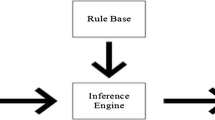Abstract
Recently fuzzy based hierarchical routing protocols such as F-MCHEL and F-SCH were proposed to improve the lifetime of a wireless sensor network. In certain cases F-MCHEL results in several small sized clusters increasing the inter cluster communication cost. This is due to the negligence of node degree in cluster head selection. The performance of F-SCH is observed to be better than F-MCHEL because super cluster head selection is based on centrality and mobility. Though it minimized inter cluster energy, the randomness in LEACH based cluster head selection inhibits the benefits of multilevel routing. Hence, with an objective to minimize the total energy consumed by the network, fuzzy based two-level hierarchical protocol is proposed. The objective is achieved by appropriate selection of cluster head and super cluster head. Cluster head selection is based on battery power, centrality and node degree while super cluster head selection is based on battery power, centrality and mobility of cluster heads. Experiments are carried out both in simulation and hardware to validate the proposal. The performance of the network in terms of first node, half node and last node death is studied and the proposal is compared with F-MCHEL and F-SCH. The results reveal the efficiency of the proposal.









Similar content being viewed by others
References
Pantazis, S. A. N., & Vergados, D. D. (2013). Energy efficient routing protocols in wireless sensor networks. IEEE Communications Surveys & Tutorials, 15(2), 551–591. https://doi.org/10.1109/SURV.2012.062612.00084.
Karkavandi, H. R., Pecht, E., & Yadid, O. (2011). Effective lifetime aware routing in wireless sensor networks. IEEE Sensors Journal, 11(12), 3359–3367. https://doi.org/10.1109/JSEN.2011.2159110.
Al-Karaki, J. N., & Kamal, A. E. (2004). Routing techniques in wireless sensor networks: A survey. IEEE Wireless Communication, 11(6), 6–28. https://doi.org/10.1109/MWC.2004.1368893.
Abbasi, A. A., & Younis, M. (2007). A survey on clustering algorithms for wireless sensor networks. Computer Communications, 30(14–15), 2826–2841. https://doi.org/10.1016/j.comcom.2007.05.024.
Heinzelman, W. B., Chandrakasan, A. P., & Balakrishnan, H. (2000). Energy-efficient communication protocol for wireless micro sensor networks. In The proceedings of 33rd Hawaii international conference on system sciences (pp. 3005–3014). Maui, HI: IEEE. https://doi.org/10.1109/HICSS.2000.926982.
Heinzelman, W. B., Chandrakasan, A. P., & Balakrishnan, H. (2002). An application-specific protocol architecture for wireless micro sensor networks. IEEE Transactions on Wireless Communications, 1(4), 660–670. https://doi.org/10.1109/TWC.2002.804190.
Lu, C., Qian, D., & Wu, W. (2008). An energy efficient weight-clustering algorithm in wireless sensor networks. In The proceedings of Japan-China joint workshop on frontier of computer science and technology (pp. 30–35). Nagasaki: IEEE. https://doi.org/10.1109/fcst.2008.24.
Lee, J.-S., Cheng, W.-L., & Lee, J.-S. (2012). Fuzzy based clustering approach for wireless sensor networks using energy predication. IEEE Sensors Journal, 12(9), 2891–2896. https://doi.org/10.1109/JSEN.2012.2204737.
Ando, H., Barolli, L., Durresi, A., Xhafa, F., & Koyama, A. (2010). An intelligent fuzzy based cluster head selection system for wireless sensor network and its performance evaluation. In The proceedings of 13th international conference on network based information systems (pp. 55–61). Takayama, Gifu: IEEE. https://doi.org/10.1109/nbis.2010.72.
Hemavathi, N., & Sudha, S. (2014). A fuzzy based predictive cluster head selection scheme for wireless sensor networks. In The proceedings of 8th international conference on sensing technology (pp. 560–567). Liverpool, UK.
Uma Maheswari, D., Meenalochani, M., & Sudha, S. (2016). Influence of cluster head position on the lifetime of WSN—A case study. In The proceedings of 2nd international conference on next generation computing technologies (NGCT) (pp. 378–381). Dehradun: IEEE. https://doi.org/10.1109/ngct.2016.7877445.
Hong, J., Kook, J., Kwon, D., Lee, S., & Yi, S. (2009). T-LEACH: The method of threshold-based cluster head replacement for wireless sensor networks. Information Systems Frontiers, 11, 513–521. https://doi.org/10.1007/s10796-008-9121-4.
Bajaber, F., & Awan, I. (2011). Adaptive decentralized re-clustering protocol for wireless sensor networks. Journal of Computer and System Sciences, 77(2), 282–292. https://doi.org/10.1016/j.jcss.2010.01.007.
Guo, P., Jiang, T., Zhang, K., & Chen, H. H. G. (2009). Clustering algorithm in initialization of multihop wireless sensor networks. IEEE Transactions on Wireless Communications, 8(12), 5713–5717. https://doi.org/10.1109/TWC.2009.12.080042.
Tarhani, M., Kavian, Y. S., & Siavoshi, S. (2014). SEECH: Scalable energy efficient clustering hierarchical routing protocol in wireless sensor network. IEEE Sensors Journal, 14(11), 3944–3954. https://doi.org/10.1109/JSEN.2014.2358567.
Lee, J.-S., & Kao, T.-Y. (2016). An improved three-layer low-energy adaptive clustering hierarchy for wireless sensor networks. IEEE Internet of Thing Journal, 3(6), 951–958. https://doi.org/10.1109/JIOT.2016.2530682.
Sharma, T., & Kumar, B. (2012). F-MCHEL: Fuzzy based master cluster head election leach protocol in wireless sensor network. International Journal of Computer Science and Telecommunication, 3(10), 8–13.
Nayak, P., & Devulapalli, A. (2016). A fuzzy logic-based clustering algorithm for WSN to extend the network lifetime. IEEE Sensors Journal, 16(1), 137–144. https://doi.org/10.1109/JSEN.2015.2472970.
Ando, H., Kulla, E., Barolli, L., Durresi, A., Xhafa, F., & Koyama, A. (2011). A new fuzzy-based cluster-head selection system for WSNs. In The proceedings of international conference on complex, intelligent and software intensive systems (pp. 432–437). Seoul Korea: IEEE. https://doi.org/10.1109/cisis.2011.69.
Handy, M. J., Haase, M., & Timmermann, D. (2002). Low energy adaptive clustering hierarchy with deterministic cluster-head selection. In The proceedings of 4th international workshop mobile wireless communication networks (pp. 368–372). IEEE. https://doi.org/10.1109/mwcn.2002.1045790.
Hemavathi, N., Nagpal, S. K., & Sudha, S. (2017). Impact of rate of recurrent communication of sensor node on network lifetime in wireless sensor network. IET Science, Measurement and Technology, 11(4), 473–479. https://doi.org/10.1049/iet-smt.2016.0290.
Author information
Authors and Affiliations
Corresponding author
Additional information
Publisher's Note
Springer Nature remains neutral with regard to jurisdictional claims in published maps and institutional affiliations.
Rights and permissions
About this article
Cite this article
Uma Maheswari, D., Sudha, S. Node Degree Based Energy Efficient Two-Level Clustering for Wireless Sensor Networks. Wireless Pers Commun 104, 1209–1225 (2019). https://doi.org/10.1007/s11277-018-6076-8
Published:
Issue Date:
DOI: https://doi.org/10.1007/s11277-018-6076-8




